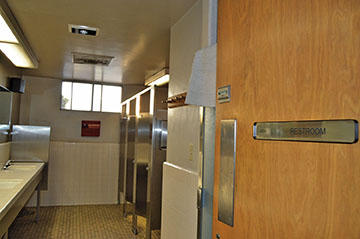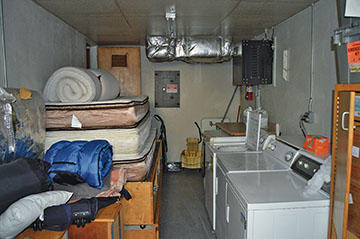After receiving a report that the City of Long Beach has $2.8 billion in unfunded public infrastructure projects to complete over the next decade, the city council at its meeting on December 22, 2015, requested that city staff explore new options for generating revenue.
During the meeting, City Engineer and Deputy Director of Public Works Sean Crumby presented a report on the condition of streets, bridges, sidewalks, alleys, public safety facilities, storm drains, community centers, parks, energy efficiency and technology.

Renovations planned for Long Beach Fire Department facilities, such as Station 4, pictured, include adding separate restrooms for genders. Currently, men and women firefighters and personnel share the same restroom by switching out a sign on the door. The station’s roof is also being replaced. Renovations will take about eight weeks to complete, during which time Engine 4 will work from Station 8 in Belmont Shore, and the basic life support unit will be assigned to Station 14 by the Colorado Lagoon. Next in line for repairs are Fire Stations 2 and 22, followed by Fire Station 10. (Photograph by the Business Journal’s Larry Duncan)
The report states that the city in Fiscal Year (FY) 2015 spent $113.5 million on public infrastructure. For FY 2016, the city has budgeted a total of $67.6 million for public infrastructure projects, including those funded by federal, state and regional grants.
Still, the city needs $212.4 million more annually to bring public infrastructure up to par over the next 10 years, according to the report.
“Despite the progress that’s been made, there remains a lot more to do,” said Crumby, who was hired in August from the City of Seal Beach. “Long Beach is at a critical juncture with aging infrastructure and facilities.”
In March 2015, a report entitled “State of Our Streets,” indicated that the current average pavement condition index (PCI) for the city’s network of streets is 60, a “Fair/Good” rating. The city’s major roadways are in “good” condition with a PCI score of 63 while minor roadways are in “fair” condition with a PCI score of 56.
However, according to city staff, there is currently a 20 percent backlog of street repairs. City staff note that backlogs that exceed 20 percent tend to be “unmanageable” from a funding point of view unless “aggressively checked through larger rehabilitation.”
“The cost of repair and maintenance of streets increases as the condition becomes worse,” Crumby said. “Without adequate funding to reduce that backlog, needs increase every year.”
A “fix-all” solution to eliminate the backlog of street repairs would require $170 million for major roadways and $250 million for local and residential streets over the next 10 years, according to city staff.
In an interview with the Business Journal, Crumby said maintenance of public infrastructure has been deferred mainly because of the Great Recession as the city has struggled to deal with budget deficits.
“We have invested in our city’s infrastructure, and we’ve done a tremendous amount, but one point I’d like to make is that we’ve just gone through this Great Recession,” he said. “The city has weathered a fiscal situation, and there has been a tremendous amount of deferred maintenance through that period. That deferred maintenance definitely takes a toll.”
In addition, the condition of more than 400 civic buildings, including fire stations and park facilities totaling more than 6.8 million square feet citywide, received a rating of “poor,” according to the recent report, which Crumby said took about three months to compile, mostly using master planning documents.
Overall, the city needs funding for $1.4 billion in transportation projects, $1 billion in civic infrastructure projects and $400 million in maintenance over the next decade, according to the report.

In early February, renovations will begin on the Long Beach Fire Department’s Fire Station 4, located at 411 Loma Ave., including upgrades to the station’s laundry room, pictured at left. (Photograph by the Business Journal’s Larry Duncan)
Despite projected budget deficits in coming years because of declining oil revenue and rising labor costs, 8th District Councilmember Al Austin said upgrading public infrastructure should be a priority for the city.
The councilmember made a motion for city staff to come back to the city council in coming weeks with new options for generating revenue.
Crumby pointed out that the city is prohibited from using oil revenue for infrastructure maintenance costs because of state restrictions.
While oil revenue might be able to cover some capital improvement projects, 7th District Councilmember Roberto Uranga noted during the meeting that tough financial times might be ahead as the price of crude oil continues to drop.
Mayor Robert Garcia said the city should continue advocating that state and federal lawmakers seek more transportation dollars for cities, adding that the legislature and Congress have done “very little” to help cities pay for street repairs.
Speaking at his “State of the City” address on January 13, Garcia stressed the need to rebuild and maintain infrastructure that he said suffers from “decades of neglect.”
Stopping short of calling for tax hikes, the mayor said the coming weeks will be critical for the city to have an “honest and constructive conversation” about the need to “invest” in the city’s infrastructure.
“What kind of city do we want to live in?” Garcia asked. “Or as my predecessor Mayor [Bob] Foster liked to say, what kind of city will we leave for the next generation? And what are we willing to invest to ensure that happens?”
